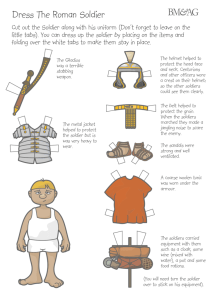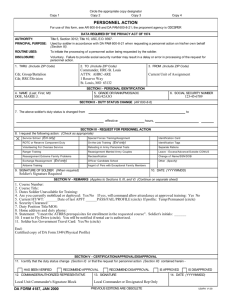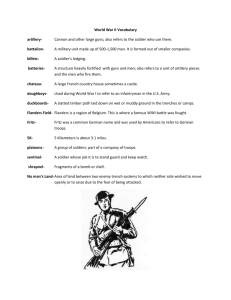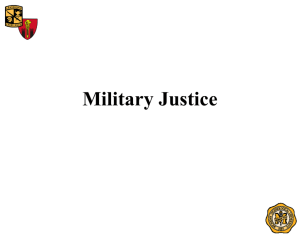File
advertisement
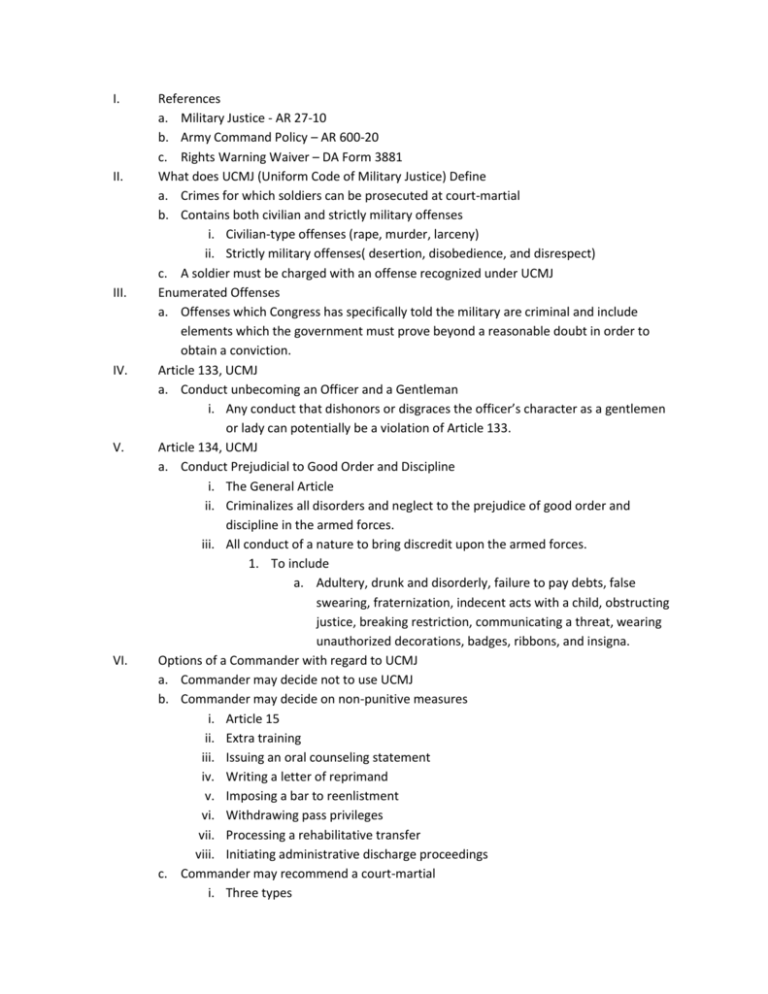
I. II. III. IV. V. VI. References a. Military Justice - AR 27-10 b. Army Command Policy – AR 600-20 c. Rights Warning Waiver – DA Form 3881 What does UCMJ (Uniform Code of Military Justice) Define a. Crimes for which soldiers can be prosecuted at court-martial b. Contains both civilian and strictly military offenses i. Civilian-type offenses (rape, murder, larceny) ii. Strictly military offenses( desertion, disobedience, and disrespect) c. A soldier must be charged with an offense recognized under UCMJ Enumerated Offenses a. Offenses which Congress has specifically told the military are criminal and include elements which the government must prove beyond a reasonable doubt in order to obtain a conviction. Article 133, UCMJ a. Conduct unbecoming an Officer and a Gentleman i. Any conduct that dishonors or disgraces the officer’s character as a gentlemen or lady can potentially be a violation of Article 133. Article 134, UCMJ a. Conduct Prejudicial to Good Order and Discipline i. The General Article ii. Criminalizes all disorders and neglect to the prejudice of good order and discipline in the armed forces. iii. All conduct of a nature to bring discredit upon the armed forces. 1. To include a. Adultery, drunk and disorderly, failure to pay debts, false swearing, fraternization, indecent acts with a child, obstructing justice, breaking restriction, communicating a threat, wearing unauthorized decorations, badges, ribbons, and insigna. Options of a Commander with regard to UCMJ a. Commander may decide not to use UCMJ b. Commander may decide on non-punitive measures i. Article 15 ii. Extra training iii. Issuing an oral counseling statement iv. Writing a letter of reprimand v. Imposing a bar to reenlistment vi. Withdrawing pass privileges vii. Processing a rehabilitative transfer viii. Initiating administrative discharge proceedings c. Commander may recommend a court-martial i. Three types VII. VIII. IX. 1. Summary 2. Special 3. General Summary Court Martial a. Provides for the disposition of minor offenses under simplified procedures b. Normally convened by a Battalion Commander c. Can only try enlisted personnel d. Presiding official is a commissioned officer usually field grade e. Accused is not entitled to a military defense lawyer f. A soldier can hire a civilian defense lawyer g. A soldier must consent to disciplinary action under summary court-martial. i. If the soldier objects, the case can then be sent to a higher level court-martial. h. Company Commander does not have the authority to convene a summary court-martial. i. He/she can send the case to the battalion commander with recommendations as to disposition. i. Maximum Punishment i. Not to exceed confinement of one month ii. Hard labor without confinement 45 days iii. Restriction for two months iv. Forfeiture of two-thirds of one month’s base pay reduction to grade of E-1 1. Soldiers grades E-5 to E-9 may only be reduced one grade and may not be confined or placed in hard labor without confinement Special Court Martial a. The intermediate trial court in the military’s criminal justice system b. Convened by a Brigade commander c. Can try enlisted, warrant officers, and commissioned officers d. Two forms i. Military Judge (at least three member jury) ii. Military Judge sitting alone e. Maximum punishment i. Forfeiture of two-thirds base-pay per month for six month ii. Confinement for six months and reduction to grade of E-1 iii. An enlisted soldier can separated from the military, if the General court-martial convening authority specifically authorizes a punitive discharge iv. Commissioned officers may not be dismissed or confined at a special courtmartial. General Court Martial a. Highest military trial court b. Usually convened by a General Officer c. Requires more detailed administrative procedures than either a summary or special court-martial d. Requires an Article 32 investigation. X. XI. XII. XIII. XIV. XV. e. Maximum punishment i. Any sentence authorized by the president of the United States. ii. To include 1. Dishonorable discharge 2. Dismissal 3. Confinement for life or a lessor period 4. Forfeiture of all pay and allowances 5. Death sentence Leader’s Role in the judicial process a. Simply to dispose of an instance of misconduct or to make an independent recommendation to a superior officer that he dispose of misconduct. b. The company commander is the first person in the military justice system with formal authority to dispose of cases of misconduct. Leaders must consider a. Character and military service of the accused. b. Nature and circumstance of the offense c. The extent of harm caused i. Morale, health, safety, welfare, and discipline d. Justice-based system reinforces your unit’s good order and discipline e. Appropriateness of the authorized punishment to the particular accused of offense f. Possible improper motives of the accuser g. Reluctance of the victim or others to testify h. Cooperation of the accused in apprehension or conviction of others i. Availability and admissibility of evidence j. Jurisdiction over accused and offenses A soldier can be tried in a civilian court and then a military court An investigation must begin when a. A soldier is accused of a crime or suspected of committing a crime AR 15-6: Non-criminal Investigations a. Are not open b. A commander at any level can conduct a formal or informal non-criminal investigation c. A commander at any level can appoint an investigating officer to determine facts and make recommendations ( Must be) i. Commissioned Officer ii. Warrant Officer iii. DA Civilian GS13 or higher d. Investigating officer must consult with JAG before beginning the investigation Article 32 Investigation a. Must be conducted before a General Court Martial can occur b. Each charge and specification must be thoroughly and impartially investigated. c. The purpose of the charge is to i. inquire into the truth of the charges XVI. ii. consider the form of the charges iii. make recommendations as to their disposition d. Typically directed by the BDE Commander (Special Court Martial convening authority) e. Right of the accused under Article 32 Investigation i. Attend the hearing ii. Present Evidence iii. Cross examine witnesses iv. Right to counsel f. Investigating Officers i. Findings of Fact ii. Recommendations iii. Accused receives a copy of report iv. Accused files objections within five days v. Convening authority take action g. Preliminary inquiry i. The process of an initial investigation conducted by a commander when he receives information that a member of his command is accused of a crime or suspected of committing a crime. Search and Seizure a. A common method of police and CID to investigate a crime is to search for and seize evidence. b. The 4th amendment of the U.S. Constitution protects individuals from unreasonable searches and seizures. c. The application within the military reflects a balance between a soldier’s privacy interest and the demands of military necessity and national security. d. Only the following personnel may authorize a search and seizure i. Commander ii. Military Judge iii. Military Magistrate e. Authority to Search i. On installations worldwide, the commander with authority over the place to be searched may authorize a search of that place. ii. CONUS – The commander that controls the military property may authorize a search (military vehicles or equipment). 1. A commander cannot authorize the search of a soldier’s off-post quarters or personal property. iii. OCONUS – A commander that controls the military property may authorize a search. 1. A commander may also authorize a search of off-post quarters or personal property so long as he has the authority over the person by treaty or local government. f. Authority of apprehend i. Generally, if there is probable cause to believe the a soldier committed an offense, then any commissioned, warrant, petty, or non-commissioned officer, or law enforcement official may apprehend the person without need for authorization from a commander, judge, or magistrate. 1. When apprehension is made in the home a warrant or authorization is required. a. On-post housing typically requires authorization from the garrison commander (commander with control of the dwelling) or authorization from a magistrate b. Apprehension off-post requires a warrant from a civilian magistrate or judge. g. Search and Seizure Requirements i. Probable Cause – A reasonable belief that the person to be apprehended is committing or has committed a crime. ii. Totality of circumstance – Taken all the information available about the person or items sought, is it reasonable to believe that the person committed the offense or that the items sought will be found in the place to be searched. iii. Neutral and Detached – When the commander authorizes an apprehension or search, he is acting in a judicial capacity 1. Must be fair and impartial 2. Commander cannot act as both investigator and judge h. Types of Search and Seizure i. Consent 1. No probable cause 2. Must be voluntary. Given freely by person searched. 3. May be partial or limited (restricted) ii. Incident to apprehension 1. Any person who has been properly apprehended may be searched to ensure the safety of the apprehending official and others, and to prevent destruction of evidence. iii. Exigent Circumstances 1. A search authorization is not required where the delay involved in obtaining the authorization would likely result in the removal, destruction or concealment of the evidence sought. i. Chain of Custody i. A list of items seized and who is in control of the item until offered at trial. j. Inspections i. Not a search ii. Primary purpose must be to ensure security, military fitness, good order, and discipline of a unit. iii. Does not require probable cause iv. Considered administrative v. Inspections become searches when 1. An inspection immediately follows a report that someone had committed an offense and the inspection was not previously scheduled. 2. Certain individuals in the unit are targeted for inspection 3. Soldiers are subjected to substantially different intrusions( some are patted down and some are stripped searched ). 4. If any was these occur in an inspection, and a soldier objects the government must prove at trial, by clear and convincing evidence, that the commander’s primary purpose was, in fact, administrative, and not for purposes of prosecution. vi. Proper way to conduct inspections 1. Articulate what you are doing and why you are doing it 2. Tailor the scope of the inspection to your primary purpose 3. Clarify what is and what is not subject to inspection 4. Ensure all soldiers inspected are treated equally 5. Issue clear procedures to follow in the event contraband is found 6. Consider scheduled inspections XVII. XVIII. Rights a. Rights warning under Article 31(b) UCMJ i. Right to be informed ii. Right to remain silent iii. Any statement can be used against you iv. Right to counsel b. When to advise a soldier of his/her rights i. Official Capacity 1. Requires rights warning when the questioner is acting in an official capacity ii. Questioning 1. In his or her capacity, tries to get the soldier to tell him or her something that could be used against the soldier 2. Volunteered information is not questioning iii. If an investigator re-interviews a suspect, then the investigator should re-advise him or her before beginning the questioning. iv. A suspect must answer the following questions in the following ways to waive his or her rights. 1. Do you understand your rights? Yes 2. Do you want a lawyer? No 3. Are you willing to make a statement? Yes c. A soldier may be required to present his/her identification card before being given warnings of his/her rights. Restricting a soldier XIX. XX. a. The commander must have probable cause and a reasonable belief that an offense triable by court-martial has been committed. b. The person to be restrained committed the offense and restriction is required by the circumstances. c. Four types of pre-trial restriction a soldier maybe placed under i. Withdrawal of pass privileges ii. Restriction 1. For enlisted: may be imposed by any commissioned officer 2. For officers: Requires a personal order issued by a commander to whose authority the officer is subject. iii. Arrest iv. Confinement d. Procedures of restriction i. Must notify soldier 1. Enlisted: must be delivered personally by the imposing authority or through his or her representative. 2. Officers: must be notified personally by the imposing commander or by some other commissioned officer. Unlawful Command Influence a. The unlawful assertion of authority that interferes with the fair and just administration of military justice under UCMJ. b. Who can be unlawfully influenced i. Subordinate commanders ii. Court-Martial panel members iii. Potential witnesses c. 10 Commandments of unlawful command influence i. A Commander may not order a subordinate to dispose of a case in a certain way. ii. A Commander must not have an inflexible policy on disposition or punishment iii. The Commander, if accused, may not refer the case iv. The Commander may neither select nor remove court members in order to obtain a particular result in a particular trial. v. No outside pressure may be placed on the Judge or court members to arrive at a particular decision. vi. Witnesses may not be intimidated or discouraged from testifying vii. The court decides punishment. An accused may not be punished before the trial. viii. Recognize that subordinates and staff may “commit” Command influence that will be attributed to the commander, regardless of his knowledge or intentions. ix. The Commander May Not have an inflexible attitude toward clemency x. It a mistake is made, raise the issue immediately. Article 15 UCMJ XXI. a. Valuable option to impose non-judicial punishment under the provisions of Article 15, UCMJ. b. Commanders should inquire about i. Whether the offense was committed ii. Whether the soldier was involved iii. The character and military record of the soldier c. Any Commander is authorized to administer non-judicial punishment under Article 15. d. Two types i. Summarized 1. Enlisted only 2. It is determined that should punishment be appropriate it should not exceed extra duty of 14 days, restriction for 14 days, oral reprimand or admonition, or any combination thereof. ii. Formal proceedings 1. if punishment should exceed that which is outlined for summarized 2. An officer is the subject e. Rights of a Soldier under Article 15 i. Right to remain silent ii. Right to counsel (formal proceedings only) iii. Right to demand trial iv. Decision period v. Right to call witnesses vi. The Hearing vii. The Right to Appeal DOD Homosexual Conduct Policy a. Focus of the policy is homosexual conduct , not sexual orientation b. Command will separate soldiers for homosexual i. Statements 1. A soldier who makes a homosexual statement, but who also convinces a separation board that he or she will not engage in homosexual acts, can be retained in the Army. ii. Acts iii. Marriages c. Investigating Homosexual Conduct i. Only Commanders initiate inquires ii. An inquiry must be based on credible information 1. Information that is not credible a. Mere suspicion, opinions, rumors b. Reading homosexual publications c. Going to gay bars iii. Inquiry 1. Subject has right against self-incrimination XXII. XXIII. XXIV. 2. Cannot ask soldier about his/her sexual orientation 3. Can question soldier’s supervisory chain-of-command 4. Can question persons suggested by the soldier iv. Investigating Homosexual Conduct 1. Substantial investigations require DA Approval 2. Statements made to spouses, chaplains, and attorney may be considered confidential. 3. Policy is violated if a. Investigate without commander’s permission b. Accuse soldier of violating policy without credible evidence c. Require soldier to reveal is sexual orientation d. Initiate a substantial investigation without DA approval. Anti-Harassment Policy a. A soldier harassed should seek out the chain-of-command, a chaplain, the IG, or a legal assistance attorney. b. A harassed or threatened soldier should not be investigated simply because of the harassment or threat c. Absent credible information, an investigation into a complaint of either harassment or of a threat must focus on the harassment or threat, ONLY d. Credible information discovered during the course of an investigation does not stop the requirement to properly dispose of allegations of harassment. e. Commanders must adequately address reported instances of harassment i. The focus of any investigation into alleged harassment must be on the soldier committing the harassment ii. When conducting the investigation, a commander can request the assistance of either the MPI or CID. iii. Harassed or threatened soldiers must know that their own sexual orientation will not be the subject of investigation. Extremist Organizations a. Participation is inconsistent with military service b. Organizations or activities that advocate racial, gender, ethnic hatred or intolerance. c. Commanders have widespread authority to prohibit soldiers from participating in these activities. d. Extremist organizations prohibitions i. Public demonstrations or rally ii. Attending in Uniform iii. Fundraising iv. Recruiting or Training v. Visible Leadership Role vi. Distributing Literature Hazing a. Any Conduct by a service member regardless of rank, that is cruel, abusive, humiliating, impressive, demeaning, or harmful to another service member, regardless of rank. b. Examples of hazing i. Abusive or harmful practical jokes ii. Branding iii. Tattooing iv. Body Painting v. “Blood Wings” Ceremonies vi. Forced consumption of alcohol Law of Land Warfare I. II. III. IV. V. What is Law of Land Warfare (LOW) – reflection of international legal values Legal basis a. Hague Regulations b. Geneva Conventions c. Other international treaty d. International Customary Law of Land Warfare Why do we need the LOW a. To assist commanders and soldiers in mission accomplishment b. To regulate the use of force and prohibit unlawful conduct c. To protect against unnecessary suffering and excessive collateral damage d. To promote the humane treatment of noncombatants, wounded and sick, and civilians Why do you need to follow the LOW a. Adherence promotes i. A more disciplined more effective fighting force ii. Support for U.S. operations both at home and aboard iii. An early end to hostiles iv. Reciprocal adherence to LOW by the enemy b. It the right thing to do i. Moral courage and self-discipline c. It is the law i. Violations can create an international incidents ii. War crimes are serious charges iii. War crimes embarrass the U.S. and limit policy options Basic principles a. Military Necessity i. Use of force, not otherwise prohibited by the LOW, which is necessary for the complete submission of the enemy as soon as possible. ii. Destructive force must be directed at legitimate military targets 1. Unavoidable destruction of non-military persons and property in the course of destroying a legitimate military target is “collateral damage” and is normally not a LOW violation. 2. Targeting of military targets those results in excessive collateral damage is unlawful. iii. Military necessity is not a defense for acts expressly prohibited by international law. b. Unnecessary Suffering/Collateral Damage i. It is forbidden for soldiers to use arms, projectiles, or material calculated to cause unnecessary suffering. ii. Prohibits weapons which cause unnecessary suffering (Fragmentary bullets) VI. iii. Prohibits the use of lawful weapons in a manner designed to cause unnecessary suffering. iv. Prohibits intentional attacks on civilians, civilian property, or collateral damage excessive in relation to a reasonably expected military advantage. c. Discrimination or distinction i. Discrimination 1. Soldiers must distinguish combatants from non-combatants 2. Military objectives from protected property or protected places. ii. Distinction 1. Soldiers must adhere to the customary international law of obligation to engage only in military operations where a. The effects distinguish between the civilian population/objects and combatants/military objectives b. Force is solely directed against combatants/military objectives d. Proportionality i. Loss of civilian life and damage to civilian property (collateral damage) must not be excessive in relation to the concrete and direct military advantage gained by an attack. ii. Proportionality is not a separate legal standard 1. It is a method for commanders to assess their obligations as to the LOW principle of distinction while avoiding actions that are indiscriminate. Ten LOW standards (The Soldier’s Rules) a. Fight only combatants i. Anyone engaging in hostilities in armed conflict on behalf of a party to the conflict. 1. Persons declared hostile 2. Persons engaged in a hostile act or demonstrating hostile intent ii. Inherent Right to Self-Defense (ROE Principle) 1. Anyone engaged in a hostile act 2. Anyone demonstrating a hostile intent b. Treat humanely all who surrender or are captured i. Follow 5 S’s and T 1. Search 2. Silence 3. Segregate a. By military rank b. Civilians from Military c. Military from Militia 4. Speed 5. Safeguard 6. Tag ii. Provide Humane treatment c. d. e. f. g. 1. Medical treatment 2. Food 3. Water 4. Shelter 5. Basic Hygiene Care 6. Clothing iii. Respect and protect 1. Protect from retaliation or retribution 2. Protect from public humiliation or curiosity 3. Respect for person, honor, cultural beliefs 4. International law applies to federal employees and contractors 5. Women a. Protected from sexual assault b. Women are entitled to respect for their persons and their honor Do not kill or torture detained personnel i. Killing and torturing personnel is a crime under international and domestic law ii. Humane treatment is the minimum standard for all detained personnel iii. Let trained interrogators conduct interrogations Collect and care for the wounded i. Once they are out of the fight, take care of them ii. Triage most seriously wounded –whether friendly or enemy iii. Safeguard from further attack iv. Mutilation or desecration of dead bodies is a violation of LOW Do not attack protected persons and protected places i. Areas with incomplete intelligence and that will cause civilian casualties are considered protected. ii. Hospitals don’t lose protected status if fortified strictly for defense 1. Doctors can have side arms 2. Armed sentries allowed 3. Can’t store weapons or co-locate with a SAM site iii. Hospitals, medics, or medical vehicles can lose their status if they are improperly used. Destroy no more than the mission requires i. Protect civilian property ii. Protect historic and cultural sites Treat all civilians humanely i. You don’t have to stop your mission to care for them ii. Do help if safe to do so and it doesn’t interfere with your mission iii. No adverse distinction based on race, religion, sex, etc. iv. No violence to life or person v. No hostage taking vi. No degrading treatment vii. Must care for the sick and wounded h. Respect private property and possessions i. Do not retain unless it is contraband ii. The taking of personal property for immediate military necessity or emergency is permissible. Issue a receipt for property taken, when possible. iii. War trophies 1. Do not retain without expressed permission of commander i. Prevent LOW violations j. Report LOW violations i. Report all suspected LOW violations (enemy or friendly) to your chain of command, judge advocate, inspector general, or chaplain ii. It is your duty to know the LOW and follow the rules iii. If you are ordered to commit a criminal act or LOW violation you are under an obligation to refuse the order. iv. “I was just following orders” is not a defense


